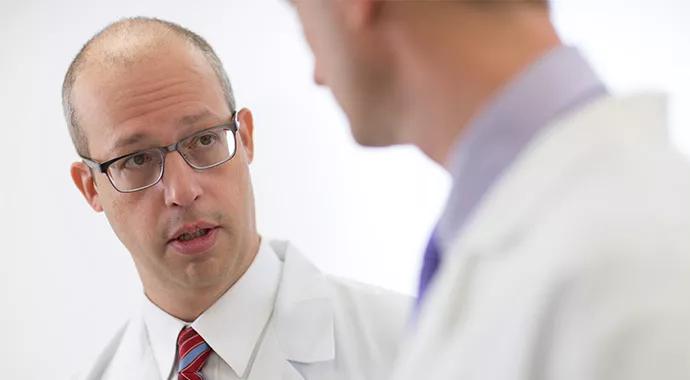Proof-of-principle studies are encouraging

Cleveland Clinic is a non-profit academic medical center. Advertising on our site helps support our mission. We do not endorse non-Cleveland Clinic products or services. Policy
Despite significant improvements in acute care aimed at reducing tissue loss from stroke, there are still hundreds of thousands of patients in the United States alone who become permanently disabled by stroke.
To date, post-acute care consists mostly of physical and occupational therapy. While most patients experience at least some recovery, approximately half of patients who suffer a stroke require long-term assistance for activities of daily living. Given current limitations, new technologies are needed to facilitate post-stroke rehabilitation. These may include electrical or magnetic stimulation, stem cell therapies or other emerging technologies.
In the past decade, major research efforts were dedicated to investigating the effects of cortical stimulation on post-stroke recovery. Despite success in proof-of-principle animal models and demonstration of safety in small patient cohorts, a large randomized study failed to show improvements beyond those achieved with rehabilitation alone.
We have proposed a different approach for applying electrical stimulation to the brain in an effort to augment recovery. Instead of aiming the electrical field at the cortical surface around the stroke, we have chosen to apply deep brain stimulation (DBS) to natural neural pathways that terminate in the perilesional cortex. This approach holds several hypothetical advantages:
Several neural pathways could be candidates for chronic DBS. Our choice was to target a long-loop neural network directly involved in post-stroke changes. The rationale for targeting the cerebello-thalamocortical pathway has been discussed in detail previously. Briefly, we based our rationale on the following:
Hence, stimulation can affect cortical areas spared after large-convexity infarctions. In a very simplistic way, one could explain our approach as reversed or upside-down crossed-cerebellar diaschisis.
Our work began with several open questions, including:
Stimulation parameters.To date, DBS therapies for conditions ranging from Parkinson disease and essential tremor to obsessive-compulsive disorder have used high-frequency (> 100 Hz) stimulation. High-frequency DBS is thought to have reversible, lesion-like effects. This is illustrated by the similar results obtained with Vim thalamotomy or Vim DBS in patients with essential tremor or Parkinson disease. However, the goal of our novel therapy is to enhance rather than diminish the cerebellar output.
To address the question of stimulation frequency, we used a rodent model of intracortical motor evoked potentials to index cortical excitability. These animals were also implanted with contralateral deep cerebellar electrodes. When cerebellar stimulation was set to high frequency, we observed a net reduction of cortical excitability, in agreement with current DBS models. We then tested the effects of various frequencies from 10 to 50 Hz. We found that frequencies between 20 and 50 Hz were associated with increments in cortical excitability but that maximal and sustained results were obtained within the beta frequency range.
First proof of principle. We also tested the effects of chronic deep cerebellar stimulation at various frequencies in a rodent model of middle cerebral artery (MCA) infarctions. Stroke was induced by microsurgical ligation of the MCA and temporary occlusion/reperfusion of the common carotid arteries. A nonsignificant trend for greater recovery was observed in animals treated with 50-Hz stimulation but not 10-Hz stimulation. However, animals treated with 20-Hz stimulation (i.e., within the beta band) presented with significantly greater recovery than did animals receiving sham treatment, that is, implanted with DBS leads and connected to stimulation apparatus but not stimulated. In this first test, animals were stimulated during 12 hours of their awake, freely moving cycle but, due to technical limitations, were disconnected from the stimulation system at the time of motor training and testing.
Paired treatment.In a recent evaluation, we changed our outcome measure for the rodent model to the pasta-matrix task. In this assessment, rats reach for pieces of pasta through a small slot, promoting use of the paw weakened by cerebral ischemia. A key advantage is that animals do not have to be disconnected from their stimulation devices during motor training/testing. Animals were divided into two groups: chronic stimulation at 30 Hz during the wake cycle, and sham treatment. In this re-evaluation we found significant improvements in motor function associated with chronic stimulation paired with motor training, indexed with the new task, relative to sham. In fact, treated animals returned to their pre-stroke baseline motor performance. We also found that chronic stimulation was associated with increased expression of synaptophysin in the perilesional cortex. Because synaptophysin is a protein present in presynaptic vesicles, this suggests that stimulation promoted recovery of function and perilesional synaptogenesis. Although these results hint at the possibility that recovery was mediated by greater synaptogenesis, causality has not been proven.
Our group still has several challenges ahead, including achievement of human translation. Next steps in the laboratory include further evaluation of possible mechanisms associated with motor recovery and testing of new, complex stimulation paradigms.
We are currently using a combination of techniques to address these questions, in collaboration with the laboratory of Grahame Kidd, PhD, and Bruce Trapp, PhD, in Cleveland Clinic’s Department of Neurosciences. Further experiments should address the question of optimal timing and duration of chronic stimulation.
Dr. Machado is a neurosurgeon and Director of Cleveland Clinic’s Center for Neurological Restoration.

Real-world claims data and tissue culture studies set the stage for randomized clinical testing

New grant-funded investigation illustrates impact and reach of Cleveland Clinic Brain Study

How the new longitudinal investigation could become the Framingham Heart Study of brain health

Pilot findings show good patient acceptance and safety, early hints of efficacy

Study finds high prevalence of symptoms, willingness to seek treatment

Panel outlines research priorities around a promising alternative to imaging markers

Suspected factors include antithrombotic intensity, time on device, presence of thrombocytopenia

Preclinical studies will assess whether method developed for stroke recovery curbs deficits after brain injury